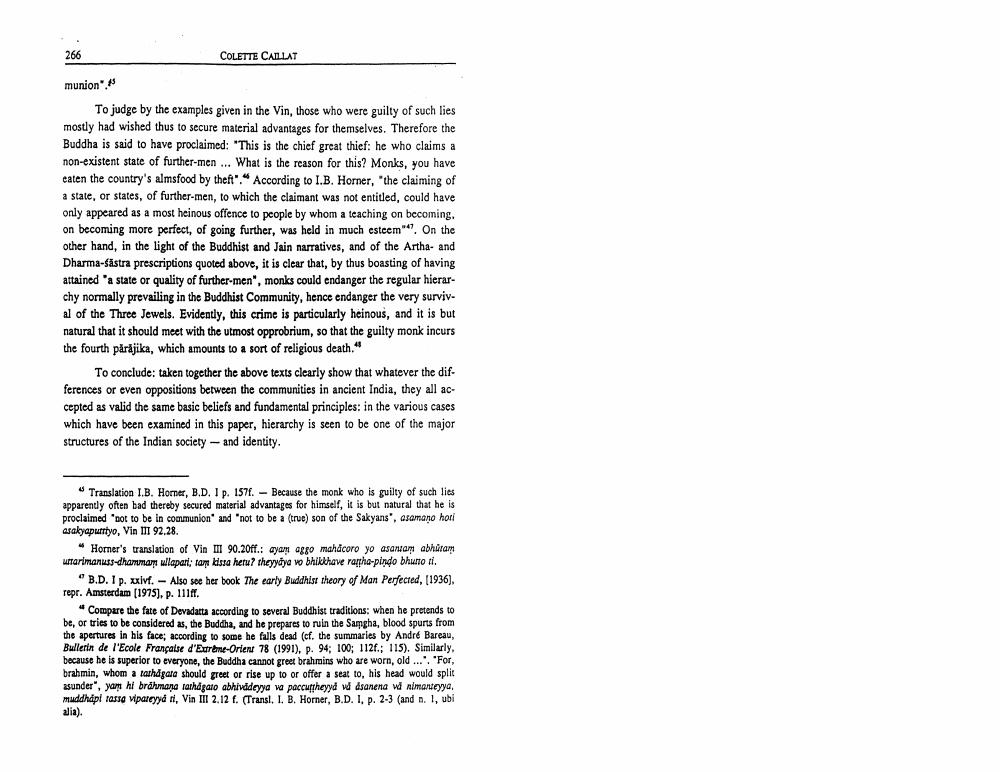________________ 266 COLETTE CAILLAT munion".IS To judge by the examples given in the Vin, those who were guilty of such lies mostly had wished thus to secure material advantages for themselves. Therefore the Buddha is said to have proclaimed: "This is the chief great thief: he who claims a non-existent state of further-men ... What is the reason for this? Monks, you have eaten the country's almsfood by theft"." According to I.B. Horner, "the claiming of a state, or states, of further-men, to which the claimant was not entitled, could have only appeared as a most heinous offence to people by whom a teaching on becoming, on becoming more perfect, of going further, was held in much esteem"47. On the other hand, in the light of the Buddhist and Jain narratives, and of the Artha- and Dharma-sastra prescriptions quoted above, it is clear that, by thus boasting of having attained "a state or quality of further-men", monks could endanger the regular hierarchy normally prevailing in the Buddhist Community, hence endanger the very survival of the Three Jewels. Evidently, this crime is particularly heinous, and it is but natural that it should meet with the utmost opprobrium, so that the guilty monk incurs the fourth parajika, which amounts to a sort of religious death." To conclude: taken together the above texts clearly show that whatever the differences or even oppositions between the communities in ancient India, they all accepted as valid the same basic beliefs and fundamental principles: in the various cases which have been examined in this paper, hierarchy is seen to be one of the major structures of the Indian society - and identity. "Translation I.B. Horner, B.D. I p. 157f. - Because the monk who is guilty of such lies apparently often bad thereby secured material advantages for himself, it is but natural that he is proclaimed "not to be in communion" and "not to be a (true) son of the Sakyans", asamano hoti asakyaputtyo, Vin III 92.28. " Horner's translation of Vin III 90.20ff.: ayam aggo mahacoro yo asantam abhutam uttarimanuss-dhammam ullapari; tam kissa hetu? theyyaya vo bhikkhave rartha-pindo bhutto ti. " B.D. I p. xxivf. - Also see her book The early Buddhist theory of Man Perfected, (1936), repr. Amsterdam (1975), p. 111ff. * Compare the fate of Devadatta according to several Buddhist traditions: when he pretends to be, or tries to be considered as, the Buddha, and he prepares to ruin the Samgha, blood spurts from the apertures in his face; according to some he falls dead (cf. the summaries by Andre Bareau, Bulletin de l'Ecole Francaise d'Extreme-Orient 78 (1991), p. 94; 100; 112f.; 115). Similarly, because he is superior to everyone, the Buddha cannot greet brahmins who are worn, old ...". "For, brahmin, whom a tathagata should greet or rise up to or offer a seat to, his head would split asunder", yam hi brahmara tathagaio abhivadeyya va paccuttheyya va asanena va nimanteyya, muddhapi tassa vipateyya ti, Vin III 2.12 f. (Transl. I. B. Horner, B.D. I, p. 2-3 (and n. 1, ubi alia).




